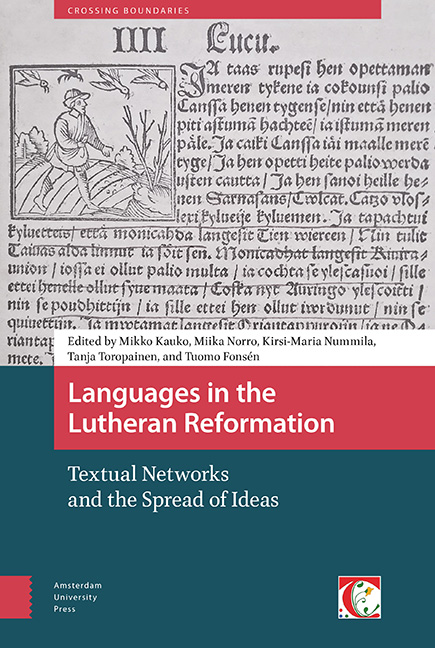Book contents
- Frontmatter
- Contents
- List of Figures and Tables
- Preface
- Introduction
- Part I The Reception of Luther's Ideas and their Influence for the Development of Written Languages
- Part II Effects of Bible Translations on the Evolution of Written Language
- Part III Reuse of (Catholic) Texts after the Reformation
- Part IV Language Contacts and Loanwords
- Index
5 - The Swedish Bible Translations and the Transition from Old Swedish to Early Modern Swedish
Published online by Cambridge University Press: 21 November 2020
- Frontmatter
- Contents
- List of Figures and Tables
- Preface
- Introduction
- Part I The Reception of Luther's Ideas and their Influence for the Development of Written Languages
- Part II Effects of Bible Translations on the Evolution of Written Language
- Part III Reuse of (Catholic) Texts after the Reformation
- Part IV Language Contacts and Loanwords
- Index
Summary
Abstract
This essay deals with the development of written Swedish in the light of early Bible translation work. The focus is on the translation of the New Testament (1526), associated with the Reformation period, which, in the history of written Swedish, has been seen as a special milestone in the transition from the Old Swedish of the Middle Ages to Early Modern Swedish. Even though the translation contains linguistic innovations and has had a powerful influence on establishing the modern written Swedish, it relies on late mediaeval linguistic usage, probably originating in urban centres. It is thus argued that it is more relevant to describe the transition between the medieval and early modern linguistic period as the expansion of a late medieval linguistic variety rather that than as a sharp break between the two.
Keywords: Swedish Language History, Bible translation history, periodization
In the historiography of the Swedish language, the New Testament translation of 1526 (NT1526) is often used to represent the beginning of the early modern language period. It is, no doubt, the single most important text of the new Early Modern Swedish, a variety which is so close to present-day Swedish that it is still legible for modern readers without too much effort. At the same time, Mediaeval Swedish (ʻOld Swedish’) generally requires of its reader proficiency in that specific language. The transition between these two varieties of Swedish can be described as the most dramatic change in the history of the language, as the entire system was affected, from lexis to syntax, morphology, and phonology. There are thus good reasons to speak about two different eras in language history.
The traditional border is furthermore stressed by the general historical changes in this period which includes the breakup of the Nordic political union, the establishment of a new regime with an efficient administration, and not least the introduction of the Lutheran Reformation programme. However, among historians there are several different alternative models for understanding how the centuries before and after 1500 relate to each other. Some speak of ʻthe long Middle Ages’, for instance, emphasizing the fact that many cultural features did not change at the beginning of the 16th century but continued to be important in the centuries to come. Others, particularly among specialists on the Reformation, recognize a period of its own, comprising parts of the 14th to the 17th centuries.
- Type
- Chapter
- Information
- Languages in the Lutheran ReformationTextual Networks and the Spread of Ideas, pp. 129 - 148Publisher: Amsterdam University PressPrint publication year: 2019



